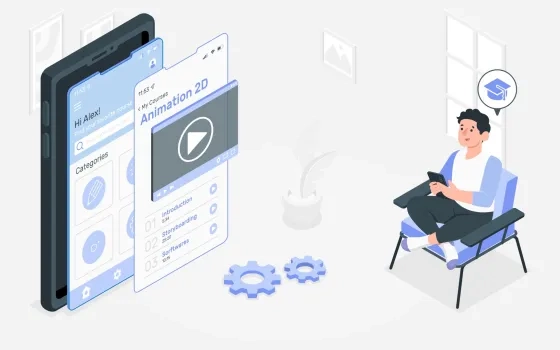Over the last two years, the world has literally moved online.
What once seemed impossible turned into reality in a matter of weeks.
Today, being online means being able to continue education. The global eLearning market is expected to grow to $375 billion by 2026. That’s why many companies wonder how to create an educational app and take part in the lucrative eLearning market.
Custom eLearning development is a process consisting of different steps. Below is the process overview on how to create a learning app:
1. MARKET RESEARCH & COMPETITORS ANALYSIS
Before the actual custom eLearning development starts, you need to cover a number of other essential stages. One of the most important ones is market analysis to better understand market state, your key competitors, their strengths and weaknesses. This information will help you later decide on the feature set for eLearning app development.
2․ COME UP WITH A USP
Before moving on to custom eLearning development, you need to decide on the Unique Selling Proposition. The worst mistake you can make is trying to copycat an already existing and successful solution like Udemy or edX.
Try to come up with a really unique idea that will be different from competition. It doesn’t necessarily mean that you need to revolutionize the whole approach to online education. You can add a special touch to your application by adding a unique feature or two.
3․ CREATE EDUCATIONAL CONTENT
Not the tools you use to build an educational app make it great, but the content you provide.
What type of eLearning application are you going to create?
The answer will help you decide on the process of content creation. If you are an educational institution you can create educational content yourself. In other cases, you can follow suit with edX and Coursera and partner up with other educational institutions and universities, like MIT, Harvard, etc.
4․ FIND A SOFTWARE DEVELOPMENT COMPANY
Now that you know what app type you want to create, you can start looking for an eLearning app development company.
You can start the research at platforms such as Clutch, The Manifest, GoodFirms, etc., where you can find companies from all over the world, learn about the provided services, check client reviews and portfolios.
5. ELEARNING APP DEVELOPMENT & DESIGN
Custom eLearning development is a process comprising two major stages: discovery and development.
The discovery stage is dedicated to the analysis and finalization of your business idea. This stage results in the product backlog, functional specifications, and, more importantly, UX/UI design of your future application. The user experience and user interface of your website should be clean, engaging, and interactive.
The eLearning application development stage covers the creation of the code base of our application.
There are a number of approaches to how you can handle the process. You can either start small and create a Minimum Viable Product (MVP) for a single platform (iOS, Android, Web), test your idea with real users, get their feedback and implement improvements based on the collected data.
6. PROMOTE YOUR ELEARNING APP
You might have the brightest idea on how to create an educational app, but it will be doomed if no one knows about it. Marketing and promotion will help you introduce your solution to the world and grow your user base.
You can use different types of promotion, including:
- Paid ads – ads across Google, Facebook, LinkedIn, Instagram and other platforms will help you get the first users.
- SMM – social media marketing is a most powerful tool when it comes to building a meaningful relationship with your target audience, current and potential customers.
- Influencer marketing – working with influences in a specific niche is one of the best ways to reach the loyal audience that will be interested in your product.
- Content marketing – content creation has a long-lasting outlook. Content marketing can be used to attract new audiences to your website, turn visitors into users, and help with user retention.
- Partnerships – in case you won’t create educational materials yourself, ask your partners to promote their courses along with your application.
HOW EDUCATIONAL APPS MAKE MONEY
World-wide known eLearning platforms such as Coursera and Udemy make billions of dollars helping people gain new knowledge. For example, the market value of Coursera is evaluated at over $7 billion, while the valuation of Udemy is over $3.32 billion.
If you do everything right, you can turn the result of custom eLearning development into a successful business. There are a few monetization strategies that you can use for your eLearning application.
A very popular monetization model that you can incorporate in your application. Freemium allows users to access some part of the functionality for free. You can either provide access to a limited number of features or create a free trial option. Either way, users will need to pay to access the full range of features or additional educational materials, depending on how you take eLearning app development.
Subscription is another possible way to make money with an eLearning application. You can allow users to sign up for monthly, quarterly, or yearly subscriptions. In some cases, you can also offer a lifetime subscription to the whole platform or just some courses. Before you start custom eLearning development, you need to consider this option too.
This is quite a popular monetization strategy today among free applications. You can combine it with the freemium model and subscription-based model. For example, integrate your app with Google Ads to show ads to users and get money for it. At the same time, allow users to buy a subscription to get rid of in-app ads.
Udemy relies on this monetization strategy. There is no subscription that users need to pay but they need to purchase every course they want to take.
Even if you decide to implement a subscription option during custom eLearning development, you can still provide in-app purchases for additional revenue streams. For example, you can provide users with some of the options:
- Courses
- Access to additional learning materials
- LinkedIn badges and professional certificates
- Degrees and mini-degrees
As you can see, there are numerous monetization strategies that you can use for learning applications.
EMERGING TECHNOLOGY IN ELEARNING APP DEVELOPMENT
Now, if you really want to know how to create an educational app that will stand out from the ground, innovative technologies can help you achieve the required results.
Gamification
Gamification is a powerful tool for students’ motivation and user retention. You will need to come up with goals and rules on how students can achieve them. Gamification makes any eLearning application more interesting and fun, turning it into a game-like experience.
There are a number of gamification elements that you can incorporate:
- In-app currency – this can be exchanged for additional learning materials, courses, assessments, etc.
- Badges – such badges can be assigned for some specific achievement, like a 14-day studying streak or six-month milestone.
- Leaderboard – consider this feature if you plan to make a platform with group online courses. Leadership boards visible to all students will motivate them to achieve new heights and beat the competition.
VR and AR
Virtual and Augmented Reality is still quite a new technology in custom eLearning development. Big companies are already using VR technology to train their employees, for example medical education. Medical students can study the human body in utmost detail, without leaving the class rooms.
VR and AR are two technologies that can revolutionize education, especially if we are talking about professional training.
Artificial Intelligence
The use cases for Artificial Intelligence are immense. When we talk about education, the technology can be used to identify user experience, the challenges students face and create a personalized education plan based on the collected data. AI-powered chatbots can come in handy when users have some questions and need to get answers without delays.
WHAT IS THE COST OF ELEARNING APP DEVELOPMENT
We’ve finally moved to the most interesting part of the article, where we talk about custom eLearning development costs.
The basic version of an app for one platform – iOS or Android – will cost you ~$50,000 and take around 3-6 months of active custom eLearning development.
Learn more about Custom eLearning Development.




















